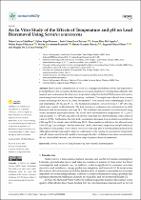| dc.contributor.author | Lecca-Caballero, Dafne | |
| dc.contributor.author | Vega-Moreno, Eyber | |
| dc.contributor.author | Cabanillas-Chirinos, Luis | |
| dc.contributor.author | Diaz Del Aguila, Karen | |
| dc.contributor.author | Rojas-Villacorta, Walter | |
| dc.contributor.author | Salvatierra-Espinola, Waldo | |
| dc.contributor.author | Nazario Naveda, Renny | |
| dc.contributor.author | Rojas-Flores, Segundo | |
| dc.contributor.author | De La Cruz-Noriega, Magaly | |
| dc.date.accessioned | 2023-11-07T15:03:03Z | |
| dc.date.available | 2023-11-07T15:03:03Z | |
| dc.date.issued | 2023 | |
| dc.identifier.uri | https://hdl.handle.net/20.500.13067/2765 | |
| dc.description.abstract | Heavy metal contamination of water is a widespread problem in Peru and represents a potential threat to the ecosystem. Bacteria are an ecological alternative to treating these effluents. This research aims to determine the influence of temperature and pH on the lead (Pb) bioremoval in surface water using Serratia marcescens under laboratory conditions. The sample was collected from a stream located in Santiago de Chuco City (Peru). Treatments (T) were carried out by combining pH (5 and 7) and temperature (25, 30, and 35 °C). The bacterial inoculum (S. marcescens) was 3 × 108 CFU/mL, which was constant in all treatments. The lead bioremoval evaluation was performed in an airlift bioreactor and the incubation time was 24 h. The total lead concentration was determined using atomic absorption spectrophotometry. The results show that treatment 6 (temperature: 35 °C, pH: 5, and inoculum: 3 × 108 UFC/mL) showed a better result than the other treatments, with a removal value of 63.94%. Furthermore, the total lead concentration decreased from an initial concentration of 0.268 mg Pb/L to a final value of 0.0964 mg Pb/L. These results are still above the allowed water value (15 µg/L) according to Peruvian standards. On the other hand, temperature and pH influenced lead removal from surface water when S. marcescens was used after a short incubation period (24 h). Although an attempt was made to improve lead bioremoval by varying two parameters, temperature and pH, future research is still needed to investigate the effect of different inoculum concentrations, the use of microbial consortia, and a broader range of physicochemical parameters. | es_PE |
| dc.format | application/pdf | es_PE |
| dc.language.iso | eng | es_PE |
| dc.publisher | MDPI | es_PE |
| dc.rights | info:eu-repo/semantics/openAccess | es_PE |
| dc.rights.uri | https://creativecommons.org/licenses/by/4.0/ | es_PE |
| dc.subject | Serratia marcescens | es_PE |
| dc.subject | Lead | es_PE |
| dc.subject | Bioremoval | es_PE |
| dc.subject | Heavy metals | es_PE |
| dc.subject | Bioremediation | es_PE |
| dc.title | An In Vitro Study of the Effects of Temperature and pH on Lead Bioremoval Using Serratia marcescens | es_PE |
| dc.type | info:eu-repo/semantics/article | es_PE |
| dc.identifier.journal | Sustainability | es_PE |
| dc.identifier.doi | https://doi.org/10.3390/su151914048 | |
| dc.subject.ocde | https://purl.org/pe-repo/ocde/ford#2.01.00 | es_PE |
| dc.source.volume | 15 | es_PE |
| dc.source.issue | 19 | es_PE |
| dc.source.beginpage | 14048 | es_PE |


